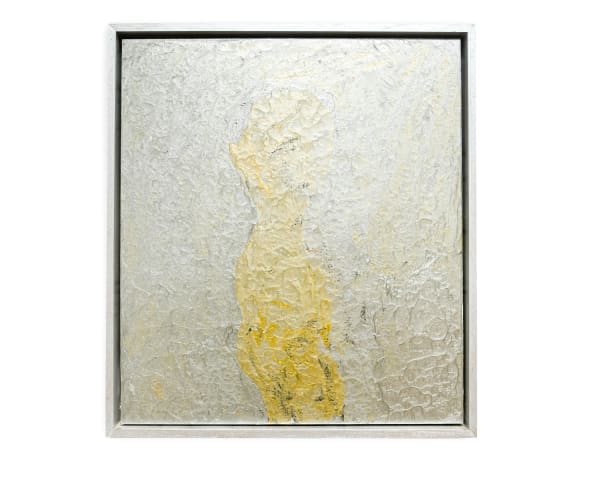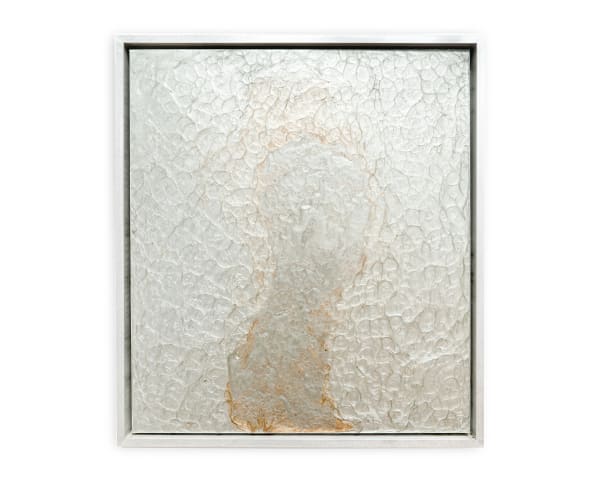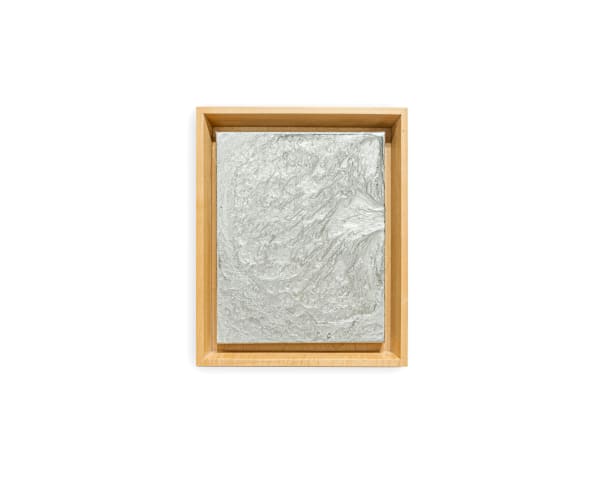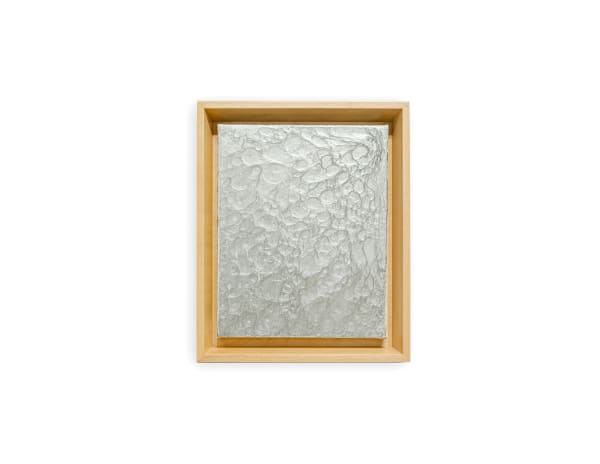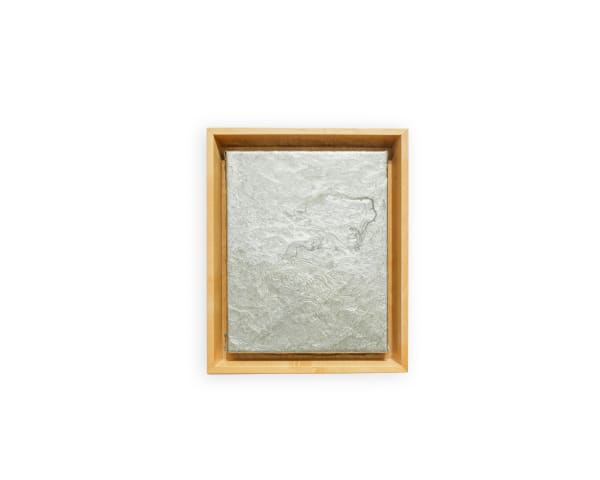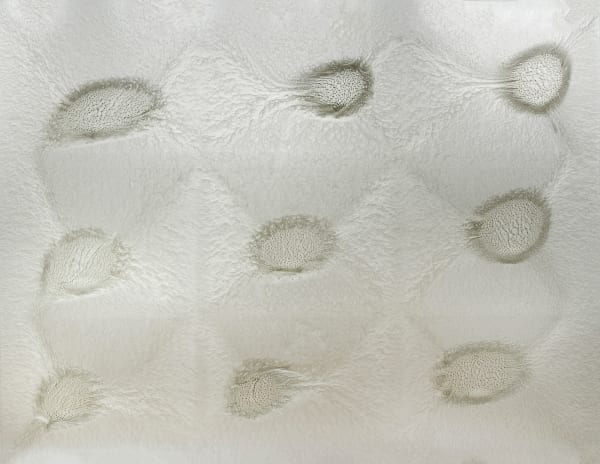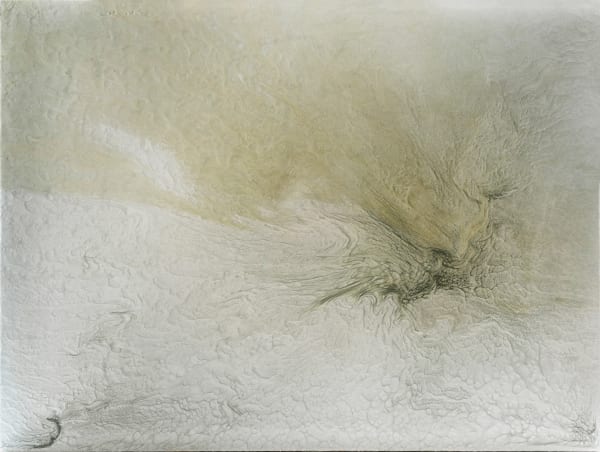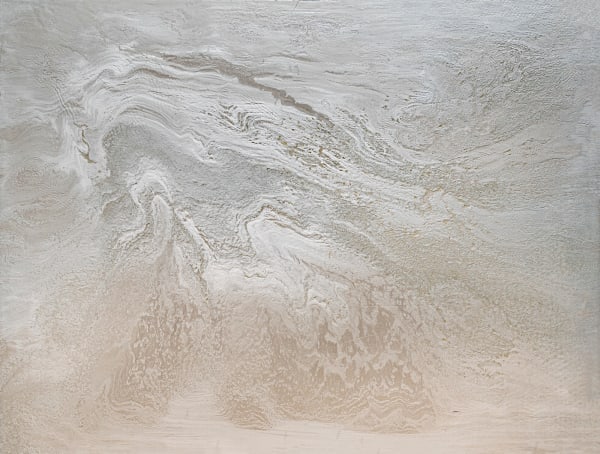-

-
Video Transcript
-

-
-
“I believe that all humans have uchuiden or ‘universal memory.’ If we access our uchuiden, then we can express it through art, music, and other forms of creativity. Discovering one’s uchuiden is a journey that anyone can make. My work is an exploration of the mysteries of my own uchuiden.”
— Hisao Hanafusa, c.2012.
The exhibition begins with obscure memories of the primordial cosmos where, the artist believes, all human beings were once interconnected. In Uchuiden Kioku QM-18, water-and oil-based aluminum paints were brushed on the canvas and left to stratify under gravity. The paints flowed and converged, drying with traces of bubbles and wrinkles upon the canvas, resulting in a flat, smooth, and shining surface. Through the materials’ kinetic organism, we experience the mysterious origins of the cosmos that abides in us and the life-force of the interconnection, quiet and mystical, that exists between us. Exhibited next to these paintings are small timber widgets from Hanafusa’s carpentry studio. Japanese carpenters and woodcarvers observe the surrounding circumstances manifested in the tree’s naturally formed shapes. The organic configuration of the timber and growth patterns in the wood determined the way the widgets were made. For Hanafusa—a painter and practicing carpenter, exploring the spontaneity of Nature under his calculated control was a career-long investigation of both material and medium. He collaborates with Nature through the material, and attains with it an alchemy that bewilders materiality.
-
 Hisao Hanafusa Uchuiden Kioku (Cosmic inherent memory)-QM18 Aluminum paint on canvas 80 x 104 in 203.2 x 264.2 cm
Hisao Hanafusa Uchuiden Kioku (Cosmic inherent memory)-QM18 Aluminum paint on canvas 80 x 104 in 203.2 x 264.2 cm -

-
“NATURE COULD BE ASSISTED TO ACHIEVE MASTERLY EFFECTS, BUT THE CONCEPT IN THE IMPROVER’S MIND MUST IN ITSELF BE BASED ON INTIMATE KNOWLEDGE OF NATURE’S MANIFESTATIONS.”
—— JOHN BLOFELD, THE SECRET AND SUBLIME: TAOIST MYSTERIES AND MAGIC, P. 118.
-
-
 Hisao Hanafusa, Fifth Dimension Byōbu II, 2021
Hisao Hanafusa, Fifth Dimension Byōbu II, 2021 -
 Hisao Hanafusa, Fifth Dimension-QM10, 2021
Hisao Hanafusa, Fifth Dimension-QM10, 2021 -
 Hisao Hanafusa, Fifth Dimension-QM11, 2019
Hisao Hanafusa, Fifth Dimension-QM11, 2019 -
 Hisao Hanafusa, Fifth Dimension-QM12, 2019
Hisao Hanafusa, Fifth Dimension-QM12, 2019 -
 Hisao Hanafusa, Fifth Dimension-QM13, 2015
Hisao Hanafusa, Fifth Dimension-QM13, 2015 -
 Hisao Hanafusa, Fifth Dimension-QM7, 2019
Hisao Hanafusa, Fifth Dimension-QM7, 2019 -
 Hisao Hanafusa, Fifth Dimension-QM8, 2020
Hisao Hanafusa, Fifth Dimension-QM8, 2020 -
 Hisao Hanafusa, Fifth Dimension-QM9, 2020
Hisao Hanafusa, Fifth Dimension-QM9, 2020 -
 Hisao Hanafusa, Uchuiden Kioku (Cosmic inherent memory)-QM14, 2003
Hisao Hanafusa, Uchuiden Kioku (Cosmic inherent memory)-QM14, 2003 -
 Hisao Hanafusa, Uchuiden Kioku (Cosmic inherent memory)-QM15, 2003
Hisao Hanafusa, Uchuiden Kioku (Cosmic inherent memory)-QM15, 2003 -
 Hisao Hanafusa, Uchuiden Kioku (Cosmic inherent memory)-QM16, 2003
Hisao Hanafusa, Uchuiden Kioku (Cosmic inherent memory)-QM16, 2003 -
 Hisao Hanafusa, Uchuiden Kioku (Cosmic inherent memory)-QM17, 2003
Hisao Hanafusa, Uchuiden Kioku (Cosmic inherent memory)-QM17, 2003 -
 Hisao Hanafusa, Uchuiden Kioku (Cosmic inherent memory)-QM18
Hisao Hanafusa, Uchuiden Kioku (Cosmic inherent memory)-QM18 -
 Hisao Hanafusa, Uchuiden Kioku (Cosmic inherent memory)-QM1, 2003
Hisao Hanafusa, Uchuiden Kioku (Cosmic inherent memory)-QM1, 2003 -
 Hisao Hanafusa, Uchuiden Kioku (Cosmic inherent memory)-QM19, 2000
Hisao Hanafusa, Uchuiden Kioku (Cosmic inherent memory)-QM19, 2000
-
-
About Artist
Curated by Dr. Tingting Xu, 14 September - 17 December 2022
Join our mailing list
* denotes required fields
We will process the personal data you have supplied to communicate with you in accordance with our Privacy Policy. You can unsubscribe or change your preferences at any time by clicking the link in our emails.









